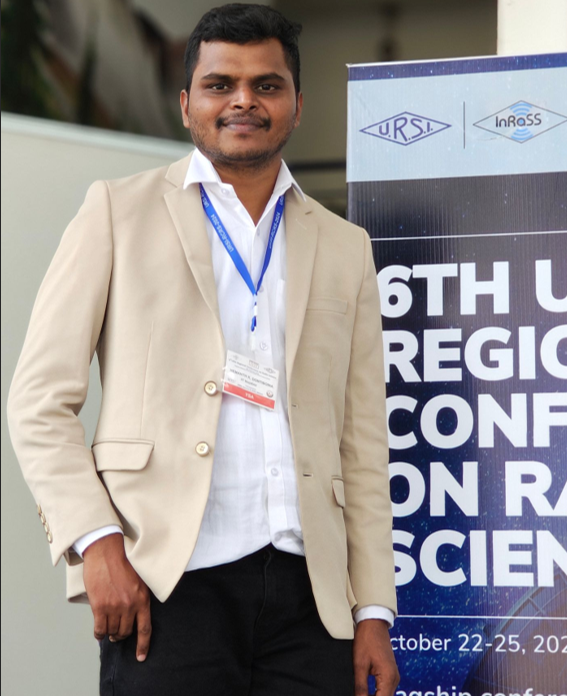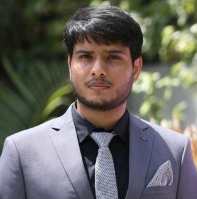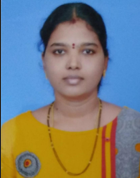
Hemant Kumar Dontiboina
Research Area: Design of microwave hyperthermia systems for preclinical studies
About research area: Hyperthermia is thermal therapy, several studies shown that improved therapeutic outcome, using hyperthermia as an adjunct therapy along with regular Chemo/radiation therapies to cure cancer. My research focuses on design and development of microwave hyperthermia systems for the preclinical In vivo and In vitro studies, to investigate the therapeutic outcome of microwave hyperthermia along with other treatment modalities to cure the cancer.

Vishal A. ( Project staff )
Research Area: Embedded in Partial Discharge (PD) Detection Using UHF Sensors and FPGA
About research area: Partial discharge (PD) is a localized dielectric breakdown in high-voltage equipment, which can lead to insulation failure if undetected. PD emissions are stochastic and produce nanosecond-duration bursts with frequency components in the UHF range in GHz. Detecting and analyzing these signals is crucial for condition monitoring and predictive maintenance in power systems.
My research focuses on developing a UHF-based PD detection system using high-sensitivity UHF antennas.The captured signals are FPGA-based processing enabling high-speed signal acquisition and real-time thresholding.
The ultimate goal is to develop a robust, low-latency PD detection system that minimizes noise interference, enhances detection accuracy, and enables remote condition monitoring of high-voltage apparatus for real-time PD pulse detection and cloud-based data logging.

Joseph Prashanth Britto (Ph.D Scholar)
Research Area: Design and Development of Sequential Microwave Hyperthermia (HT) & High Dose Rate Brachytherapy (HDR-BT) Applicator for the treatment of Cervical Cancer (CC)
About research area: Unlike external HT treatment delivered using phased array of microwave and RF antennas along with external beam RT (EBRT), it is proposed to deliver HT as an adjuvant treatment along with high dose rate (HDR) brachytherapy (BT) for Cervical Cancer (CC). HDR BT is delivered as a boost RT to CC patients to improve local control of the disease after EBRT treatment. As the disease extent for boost RT delivered using HDR-BT is relatively smaller compared to EBRT, it is proposed to deliver targeted HT to the cervix using custom-designed intracavitary applicators. Recent developments in targeted thermal delivery and composite/additive manufacturing techniques have led to interest in the development additive manufactured intracavitary applicators for RT and HT treatment of cancer. The challenge is to design and fabricate structurally strong microwave transparent Novel catheters and applicators for delivering targeted sequential HT treatment along with HDR-BT for CC.

Rahul Choudhary
Research Area: Microwave Phased array applicator based hyperthermia treatment system for treatment of locally advanced breast cancer
About research area: : Hyperthermia treatment, also known as thermal therapy, uses heat to damage and kill cancer cells. It's often used in combination with other cancer treatments like chemotherapy and radiotherapy. We are working on designing microwave phased array based systems and tools for hyperthermia treatment of locally advanced breast cancer.

Muthu Rattina Subash (MS+PhD, Prime Minister Research Fellow)
Research Area: Design and development of 434 MHz microwave antennas with varying aperture sizes for hyperthermia treatment of superficial cancers, including chest wall recurrences (CWR), soft tissue sarcomas, skin cancers, head and neck cancers, and tumors extending up to 3–4 cm from the skin surface. Additionally, design of 434 MHz antenna arrays and beamforming algorithms for the treatment of diffuse cancers with spatially controlled power deposition. Research also focuses on beamforming algorithms in ultrasound imaging and the development of ultrasound signals based algorithms for non-invasive deep tissue temperature estimation, providing real-time feedback for microwave antennas during hyperthermia treatment.
Research Interest: Microwave antennas, Antenna arrays and beamforming, RF signal integrity analysis, Coupled electromagnetic - thermal analysis, Ultrasound beamforming and imaging, Ultrasound thermal strain imaging and RF digital signal processing
Researchgate: https://www.researchgate.net/profile/Muthu_Ramu4

Mohan R (PhD Scholar, HTRA fellowship)
Research Area: Wearable microwave radiometer for core body temperature measurement.
About research area: : Wearable microwave radiometry is a cutting-edge, non-invasive technology for measuring core body temperature. It uses low-power microwave signals to detect thermal radiation from deep tissues, offering accurate, continuous monitoring. Compact and wearable, it’s ideal for healthcare, sports, and safety applications, providing real-time insights without discomfort. This innovation is beneficial for detecting fever, heat stress, or other temperature-related conditions early. My work focuses on designing miniaturized antenna and radiometer configuration for wearable microwave radiometer devices.
Neenu V S (PhD scholar)
Research Area: Development of a handheld device for breast cancer screening using microwave radiometry.
About research area: Microwave radiometry (MR) is a passive and non-invasive technique, which measures the thermal radiation emitted by a body in the microwave regime of electromagnetic (EM) spectrum gathered using an antenna i.e., sensor, connected to a radiometer. One of the major applications of a microwave radiometer is to detect the presence of a tumor based on its temperature gradient compared to the neighboring tissues. Unlike infrared thermal cameras, microwave radiometers can detect thermal hot spots several centimeters deep inside the tissue. The thermal emission in the microwave frequency gathered by the antenna in contact with the body is processed by the radiometer to determine the volume average temperature of the tissue. My work is focused on developing miniaturized antennas and radiometers for integrating into a portable handheld device for the detection of breast cancer.

Vijayalakshmi G (PhD Scholar)
Research Area:Design of a handheld instrument for early detection of breast cancer using non invasive tools.
About research area: Breast cancer is a serious health issue faced by women across the globe with a high mortality rate if detected at later stages. Early detection of the same reduces the mortality rate. The research is aimed at early detection of breast cancer using non invasive tools like mechanical imaging and ultrasound techniques, so that the harmful radiation effects of commercially and practically available breast mammography techniques are avoided and also to be done with relatively less pain. The instrument is to be developed with higher accuracy in prediction at low cost so that it is reachable and beneficial to the rural population.
Looking for PhD, Masters and B-Tech students interested in pursuing research in Advanced EM materials, Biomedical device design and instrumentation, and EM techniques for Nondestructive testing. Feel free to mail me.